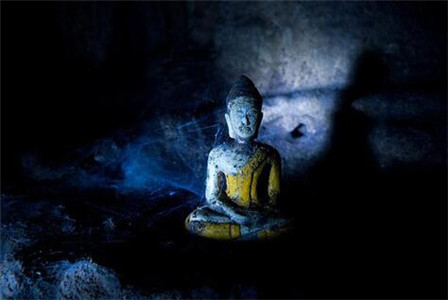涅槃的意义

[中译]良稹
Nibbana
by Ven. Thanissaro Bhikkhu
我们都了解火焰熄灭的情形。火尽烟散、寂然无迹。因此我们初次了解到,涅槃(nibbana/nirvana)这个词,作为佛教的修持目标,其字面意思是火焰的熄灭, 会感到作为一个灵性追求目标,很难想象有比彻底消亡这个形象更致命的了。不过,对于涅槃概念作这般理解,实际上是一个误会,并非在文字上,而是在形象上。对于佛陀时代的印度人来说,熄灭之火代表了什么? 绝对不是消亡。
We all know what happens when a fire goes out. The flames die down and the fire is gone for good. So when we first learn that the name for the goal of Buddhist practice, nibbana (nirvana), literally means the extinguishing of a fire, it's hard to imagine a deadlier image for a spiritual goal: utter annihilation. It turns out, though, that this reading of the concept is a mistake in translation, not so much of a word as of an image. What did an extinguished fire represent to the Indians of the Buddha's day? Anything but annihilation.
根据古老的婆罗门信仰,火焰熄灭时进入一个潜在阶段。 它并非停止存在,而是处于静态,在这个不受燃料束缚的状态下扩散开来,弥漫于空间。 当佛陀用这个比喻对当时印度的婆罗门人士讲解涅槃之意时,绕过了熄灭之火是否继续存在的问题,而是侧重于说明,要定义不燃之火是不可能的: 因此他关于一个彻底“熄灭”者的称谓,也是不可描述的。
According to the ancient Brahmans, when a fire was extinguished it went into a state of latency. Rather than ceasing to exist, it became dormant and in that state — unbound from any particular fuel — it became diffused throughout the cosmos. When the Buddha used the image to explain nibbana to the Indian Brahmans of his day, he bypassed the question of whether an extinguished fire continues to exist or not, and focused instead on the impossibility of defining a fire that doesn't burn: thus his statement that the person who has gone totally "out" can't be described.
但是,佛陀在对自己的弟子讲解时,更多地用涅槃的形象作为自由的象征。当时的印度人,似乎都把燃烧之火看成动荡、有依赖性、禁锢状态,燃烧时既执取、又受缚于燃料。为了点火,必须把它“抓获”(seize)。 火在放弃了(letgo)燃料之后,便“自由”了,从动荡、依赖、禁锢中获得解脱,宁静、不受制约。 这就是为什么巴利文诗偈中反复以熄灭之火的形象作为自由的比喻。实际上,这个词属于火的一组类比,相关词汇另有两个。Upadana,意为执着,也指火从燃料中获得的滋养。 Khandha,不仅指界定一切缘起经验的五蕴之一——形态、感受、辨知,思维、意识,而且还指树干。 正如火停止执着、停止从木料获取滋养,便熄灭了; 心终止对五蕴的执着时,便获得了自由。

However, when teaching his own disciples, the Buddha used nibbana more as an image of freedom. Apparently, all Indians at the time saw burning fire as agitated, dependent, and trapped, both clinging and being stuck to its fuel as it burned. To ignite a fire, one had to "seize" it. When fire let go of its fuel, it was "freed," released from its agitation, dependence, and entrapment — calm and unconfined. This is why Pali poetry repeatedly uses the image of extinguished fire as a metaphor for freedom. In fact, this metaphor is part of a pattern of fire imagery that involves two other related terms as well. Upadana, or clinging, also refers to the sustenance a fire takes from its fuel. Khandha means not only one of the five "heaps" (form, feeling, perception, thought processes, and consciousness) that define all conditioned experience, but also the trunk of a tree. Just as fire goes out when it stops clinging and taking sustenance from wood, so the mind is freed when it stops clinging to the khandhas.
因此,涅槃这个形象之下的内涵是指自由。巴利论藏追溯其动词的词根为“解脱”(unbinding),也支持这个观点。是怎样的解脱? 经文中描述了两个层次。一个是此生的解脱,以火已熄灭、余烬尚温为象征,这代表已证悟的阿罗汉,有视觉听觉,敏感于喜乐,但已脱离了贪、瞋、痴。第二个层次的解脱,以火焰灭尽、余烬已冷作为象征,代表了阿罗汉此生以后的经验。来自感官的一切输入冷却下来,他/她从时空存在的最细微的苦与局限中获得了解脱。
Thus the image underlying nibbana is one of freedom. The Pali commentaries support this point by tracing the word nibbana to its verbal root, which means "unbinding." What kind of unbinding? The texts describe two levels. One is the unbinding in this lifetime, symbolized by a fire that has gone out but whose embers are still warm. This stands for the enlightened arahant, who is conscious of sights and sounds, sensitive to pleasure and pain, but freed from passion, aversion, and delusion. The second level of unbinding, symbolized by a fire so totally out that its embers have grown cold, is what the arahant experiences after this life. All input from the senses cools away and he/she is totally freed from even the subtlest stresses and limitations of existence in space and time.
佛陀坚持说,这后一个层次是不可描述的,即便以存在与非存在角度也不可能,因为言辞只适于有限事物。他除了以形象和比喻之外,实际上说的只是,人在此生可以预尝终极快乐的经验,而这个经验是真正值得了解的。
The Buddha insists that this level is indescribable, even in terms of existence or nonexistence, because words work only for things that have limits. All he really says about it — apart from images and metaphors — is that one can have foretastes of the experience in this lifetime, and that it's the ultimate happiness, something truly worth knowing.
因此,下一次你目睹火焰熄灭时,不要把它作为消亡的例证,而看成从舍弃中获得自由的一课。
So the next time you watch a fire going out, see it not as a case of annihilation, but as a lesson in how freedom is to be found in letting go.
- 准提咒正确念法
- 太上清心咒全文
- 为什么晚上不能听大悲咒
- 超度经文往生咒全文
- 准提咒功德及妙用求财
- 62条人生妙言妙语,帮助你
- 诵大威德金刚咒的感应
- 长寿佛心咒注音
- 普贤行愿品全文诵读含仪轨
- 六字真言作用和功效
- 药师佛心咒正确念诵的方法
- 简单的清心咒口诀
- 六字真言的作用和功能
- 普门品念诵的正确方法
- 准提咒手印全图
- 普贤行愿品回向文全文
- 净身 口 意三业真言拼音
- 金刚经四句偈语解释
- 普贤行愿品全文念诵仪轨
- 道家静心咒原文
- 大悲咒原版30分钟mp3
- 准提咒回向文大全
- 心经可以随便抄吗
- 准提咒全文正确注音
- 天眼看持准提咒人
- 准提咒全文拼音版
- 诵金刚手菩萨圣号的感应故
- 《金刚般若波罗蜜经》
- 楞严咒快速记忆法
- 念坚牢地神咒的感应
- 财神咒念诵108遍
- 药师咒念诵正确方法有哪些
- 准提咒晚上不能念
- 家里播放普庵咒的禁忌
- 在家诵地藏经正确仪轨及回
- 普贤行愿品偈颂全文
- 念大悲咒使人阳气上升
- 《金刚经》全文-金刚经原文
- 女子在家念地藏经注意事项
- 地藏菩萨心咒108遍
- 美国慈林寺简介
- 自戒的技能
- 精进之乐
- 维持的工作
- 禅定在面对苦痛、疾病与死
- 浸于身内
- 涅槃的意义
- 社交焦虑
- 浴于气中
- 无我,还是非我?
- 正念的真义
- 正见
- 护卫禅
- 拆解当下──正思的作用
- 慈悲的教育
- 戒律的疗愈力
- 想象
- 意向的坚持
- 当你亲证之时──巴利经文
- 布施先行
- 开启佛法之门——礼敬在佛
- 归依
- 审视你正在作什么
- 定义念住
- 定的三层次
- 如何跌倒
- 坦尼沙罗尊者 答佛教杂志读
- 呼吸禅定步骤
- 四梵住
- 印证心灵真谛——佛教的“
- 去,作禅那
- 呼吸禅定引导
- 六元素
- 凝视的平稳
- 信仰与觉醒
- 你内在的暴民
- 佛教禅修: 如何与为何
- 佛陀的“应该”
- 优婆夷清-那那容
- 佛教无常观的语境
- 往生极乐世界 愿心为先
- 悟显法师:华严、法华均圆
- 我修学了凡四训的一些做法
- 张智霖:经营自己的肉身(图
- 惟觉法师:佛法与世间法
- 心律法师:忍辱苦修成大业
- 恬静安逸 清新隽美—评画家
- 我的修学报告:阿难问事佛
- 放生蛇会报恩吗?
- 恭敬心很重要
- 悟妙法师:我经常感到痛苦
- 怎样获得美好姻缘?
- 很想用所学到的佛法知识影
- 悟毅:学佛对我人生的影响
- 想清凉“爽一夏”吗?峨眉
- 往生极乐世界是为了更好地
- 念观音圣号提前合掌往生
- 大安法师:回向的功德是否
- 怎样戒烟
- 心律法师:最好的悟禅之道
- 悟显法师:印经布施开智慧
- 张继宝不孝遭雷殛
- 惟觉法师:六祖坛经 憨山大
- 放生蛇之详细攻略
- 我受了12年的等流果和增上
- 悟强:你快乐吗?谈大方和
- 恭迎伽蓝菩萨圣诞!教您唱
- 我的前半生从死阴的幽谷到
- 大安法师:因微果丰、做怪
- 往生极乐世界最殊胜
- 念佛感应见闻记:阿伽陀药
- 心律法师:脱掉你脆弱的外
- 悟显法师:口业清净不染尘
- 念佛不出声心里默念可以吗
- 悟演法师:三止三观
- 感恩上净下空老法师
- 很重要,去寺院吃饭要注意
- 悟显法师:万般将不去,唯
- 想看到僧宝的功德也需要大
- 怎样才可以彻底放开一个人














